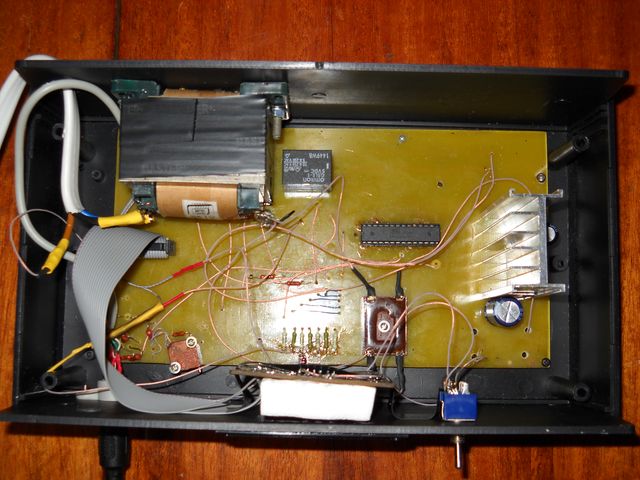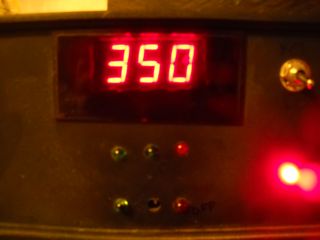Simple soldering station on a microcontroller
Soldering iron - the main tool of those who are somehow connected with electronics. But most ordinary soldering irons are suitable only for soldering pots, a more or less normal soldering iron with a thermostat and interchangeable tips is not cheap, but there is nothing to say about soldering stations. I propose to build a simple soldering station which is not particularly different in functionality from the serial one.

The microcontroller works like a thermostat: it receives data from a thermal converter and controls the transistor, which in turn turns on the heater. The set and current temperature of the soldering iron are displayed on a seven-segment display. S1-S4 buttons are used to set the temperature in increments of 100 ° and 10 ° , S5-S6 - to switch the station on and off (standby), S7 - switches the temperature indication mode: current temperature or specified (in this mode you can change ). Heater operation is indicated by LED1. In the event of a power failure, the last set temperature is stored in a non-volatile EEPROM memory, and when it is next turned on, the station starts heating up to this temperature.
The station used a 18V 40W mains transformer, any diode bridge capable of withstanding 2A current and 30V reverse voltage, for example, KC410. The integral voltage regulator 7805 must be screwed to the radiator of at least a matchbox size. Filtering capacitors C1 - electrolytic at 100-500 microfarad, C2 with a great desire, can be removed. Indicator - any three-digit with a dynamic display and a common anode, it is better to hide it behind the filter. Current-limiting resistors R8-R11 resistance 330 Ohm-1kOm. Buttons S1-S6 without fixing, preferably clock, S7 - toggle switch or button, but with fixation. Resistors R1-R7 - any resistance 10kOm-100kOm. The T1 transistor is an N-channel MOSFET controlled by a logic level, a drain-source voltage of at least 25V and a current of at least 3A, for example: IRL3103, IRL3713, IRF3708, IRF3709 and others. ATmega8 microcontroller with any suffix and package (in the numbering diagram of the contacts for DIP-case). From fyuzov we change only CKSEL: we tune to the internal 8 MHz generator CKSEL3 ... 0 = 0100, the rest do not touch. This scheme does not require any settings and works immediately (if it is properly assembled).
')
The scheme provides for the use of soldering irons used in commercially available soldering stations, such as Lukey or AOYUE. These soldering irons are sold as spare parts and cost a little more than the previously mentioned soldering irons for pots. The main difference that worries us is the type of temperature sensor, it can be a thermistor or a thermocouple. We need the first. This type of converter is suitable for soldering irons inside which is a ceramic heating element HAKKO 003 (HAKKO A1321). An example of such a soldering iron is used in Lukey 868, 852D +, 936, etc. soldering stations. Such a soldering iron is more expensive, but is considered to be of higher quality.
Lukey soldering irons have a PS / 2 connector for connecting the station, and for AOYUE it is similar to the old Soviet connector for connecting a tape recorder. On the Internet, you can find their pinouts, or you can simply cut off the connector and solder directly to the board. To find out where a wire is, you can measure resistance: the heater will have about 3 ohms, and the thermistor will have about 50 ohms (at room temperature).
Almost all modern soldering irons for soldering stations have the ability to ground the sting, use it to protect soldered parts from static discharges.
All EPSN was soldered with copper wire wound on the sting. I did not think about miniaturization then.



The insides were photographed two years ago, when it was only made, so attentive readers may notice a relay (replaced by a transistor) and a thermocouple converter (red resistors and a trimmer in the lower left corner).
The archive firmware and scheme in high resolution
Scheme

The microcontroller works like a thermostat: it receives data from a thermal converter and controls the transistor, which in turn turns on the heater. The set and current temperature of the soldering iron are displayed on a seven-segment display. S1-S4 buttons are used to set the temperature in increments of 100 ° and 10 ° , S5-S6 - to switch the station on and off (standby), S7 - switches the temperature indication mode: current temperature or specified (in this mode you can change ). Heater operation is indicated by LED1. In the event of a power failure, the last set temperature is stored in a non-volatile EEPROM memory, and when it is next turned on, the station starts heating up to this temperature.
Details
The station used a 18V 40W mains transformer, any diode bridge capable of withstanding 2A current and 30V reverse voltage, for example, KC410. The integral voltage regulator 7805 must be screwed to the radiator of at least a matchbox size. Filtering capacitors C1 - electrolytic at 100-500 microfarad, C2 with a great desire, can be removed. Indicator - any three-digit with a dynamic display and a common anode, it is better to hide it behind the filter. Current-limiting resistors R8-R11 resistance 330 Ohm-1kOm. Buttons S1-S6 without fixing, preferably clock, S7 - toggle switch or button, but with fixation. Resistors R1-R7 - any resistance 10kOm-100kOm. The T1 transistor is an N-channel MOSFET controlled by a logic level, a drain-source voltage of at least 25V and a current of at least 3A, for example: IRL3103, IRL3713, IRF3708, IRF3709 and others. ATmega8 microcontroller with any suffix and package (in the numbering diagram of the contacts for DIP-case). From fyuzov we change only CKSEL: we tune to the internal 8 MHz generator CKSEL3 ... 0 = 0100, the rest do not touch. This scheme does not require any settings and works immediately (if it is properly assembled).
')
Soldering iron
The scheme provides for the use of soldering irons used in commercially available soldering stations, such as Lukey or AOYUE. These soldering irons are sold as spare parts and cost a little more than the previously mentioned soldering irons for pots. The main difference that worries us is the type of temperature sensor, it can be a thermistor or a thermocouple. We need the first. This type of converter is suitable for soldering irons inside which is a ceramic heating element HAKKO 003 (HAKKO A1321). An example of such a soldering iron is used in Lukey 868, 852D +, 936, etc. soldering stations. Such a soldering iron is more expensive, but is considered to be of higher quality.
Finally
Lukey soldering irons have a PS / 2 connector for connecting the station, and for AOYUE it is similar to the old Soviet connector for connecting a tape recorder. On the Internet, you can find their pinouts, or you can simply cut off the connector and solder directly to the board. To find out where a wire is, you can measure resistance: the heater will have about 3 ohms, and the thermistor will have about 50 ohms (at room temperature).
Almost all modern soldering irons for soldering stations have the ability to ground the sting, use it to protect soldered parts from static discharges.
But what happened
All EPSN was soldered with copper wire wound on the sting. I did not think about miniaturization then.



The insides were photographed two years ago, when it was only made, so attentive readers may notice a relay (replaced by a transistor) and a thermocouple converter (red resistors and a trimmer in the lower left corner).
The archive firmware and scheme in high resolution
Source: https://habr.com/ru/post/136998/
All Articles